This was published 6 years ago
Monaco's other motoring thrills: Meet Michel Ferry, the high-octane aristocrat
By John Borthwick
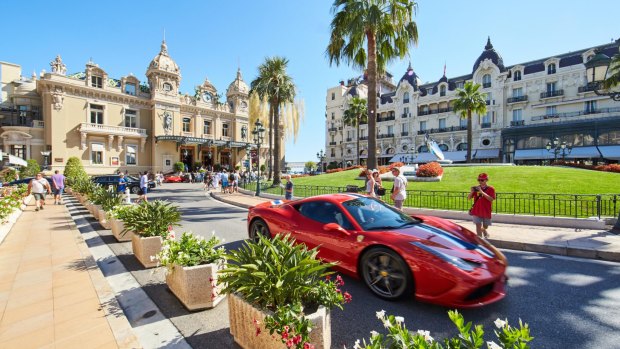
The Casino of Monte Carlo.Credit: Alamy
You'd never call Michel Ferry a petrolhead. High-octane aristocrat might be more the term. The label goes with his territory, the principality of Monaco, as well as with his role there as race director of the famous Monaco Formula One Grand Prix. The urbane, 73-year-old – "Monegasque and proud of it" – is on the record as saying that "one cannot ignore motor sport if born in the principality … it's an obligation".
Monaco is more than a casino with a UN seat, a harbour with a prince and a grand prix. The name Monaco, by the way, refers to the country – an independent principality – while the casual but inaccurate synonym "Monte Carlo" is the name of Monaco's most famous district. The Monaco Grand Prix, in late May, draws thousands of motor sport fans and millions of viewers worldwide to this 2.02-square-kilometre Mediterranean coastal enclave. Consequently, if you love the sound of 15,000 revs in the morning, you're competing against 200,000 other folk for a vantage point, where the most expensive grandstand seats for the race cost about $840 a head.
Over coffee at the harbourside Automobile Club de Monaco (the oldest auto club in the world), Ferry, who is also club vice-president, suggests to me some alternatives for motor sport aficionados. As well as its heavily in-demand grand prix, Monaco has an extensive calendar of other motoring thrills, including its famous Monte Carlo Rally, a historic car version of the same rally, e-car events, races for historic F1 cars and a jaw-dropping motor show. (See "Monaco's Fabulous Motoring Calendar" box.)
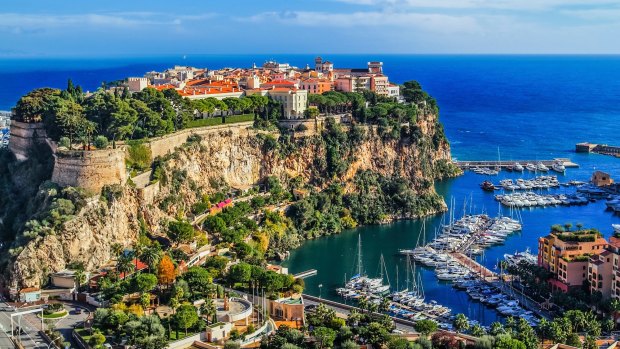
Monaco on the French Riviera.Credit: iStock
With no personal income tax, Monaco is the preferred domicile of many high-earning F1 race drivers. I ask Ferry which ones live here.
"The question should be: which ones don't live here," he says. "Basically, they all do."
Ferry says world champions Lewis Hamilton and Nico Rosberg – fierce track rivals until the latter's retirement last year – live in the same apartment block. "Lewis, of course, is three floors higher than Nico."
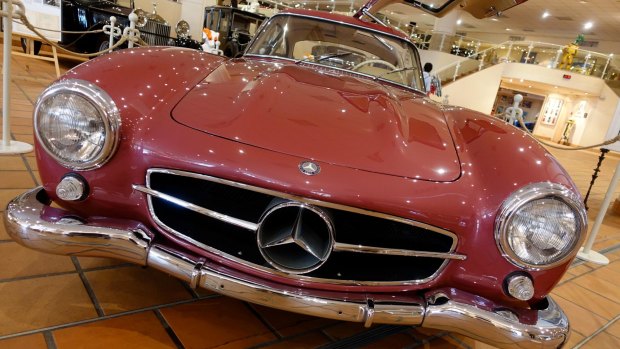
The Prince Rainier motor museum.Credit: Alamy
I ask Ferry, himself a former racer, what car he now drives. He produces his phone and swipes through his personal rides, past and present. I spot a Ferrari 275 GTB, Porsche 911, E-Type Jag, a vintage Bugatti, Renault Zoe eco-car, Harley motorbikes, an original Mini-Moke. I swear I spot an almost mythical 1950s Mercedes-Benz 300SL Gullwing coup. I tell him, "Yesterday I went to the Prince Rainier motor museum. I could have just visited your garage or borrowed your phone."
The favourite wheels of the late Prince Rainier III (who famously married Hollywood star Grace Kelly) are displayed in the Prince of Monaco's Vintage Car Collection. Stepping inside you see a 60-year-old sports car that still makes grown men groan, a 1956 Gullwing Merc, strawberry-red. It's a hard act to follow but the prince's stable of 100 vehicles manages nicely. There's a Lewis Hamilton F1 Mercedes, Lamborghinis, Maseratis and great regal chariots like a 1928 Lincoln Phaeton. The historic 1903 De Dion-Bouton is a priceless rarity while others constitute an elephant graveyard of the world's extinct luxury marques – Hispano-Suiza, Facel Vega, Delgage, Napier and more. There's even a 1956 Rolls-Royce Silver Cloud that was supposedly donated to the prince by local shopkeepers – as one does.
Monaco, the Grimaldi dynasty's sun-blessed, fiscally enhanced slice of the Cote d'Azur is ideal for walking – and if you're not in the mood for that, the public bus system is excellent and egalitarian. One way to vicariously experience Monaco's glamorous Grand Prix, minus the crowds, barriers and insanely fast cars, is to walk the track, which is well marked on tourist maps. This legendary street circuit has changed little since the first grand prix in 1929 and in a 2009 British poll was voted number one among the Seven Sporting Wonders of the World.
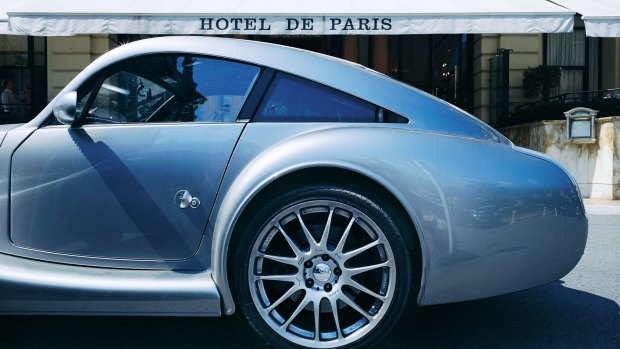
A Morgan Aeromax.Credit: Alamy
Doing the full Monte Carlo, so to speak, you can walk the F1 circuit's 3.34 kilometres and 19 turns in an hour or so, depending on your pit stops. During the race, drivers like Daniel Ricciardo and Sebastian Vettel do it 78 times – at under one minute and 20 seconds a lap – in not much longer than it takes a pedestrian to stride the circuit just once.
Instead of seeking out the pit straight or iconic hairpin bends, I'm hunting for lunch. When I ask a dapper gentleman for directions to the stylish Mozza restaurant, his reply is magnificently Monegasque – "Just turn right at the Rolls-Royce." However, it's not just one Roller at the corner but a whole showroom of opulent Silver Wraith land whales. Yet even these leviathans are kicked to the kerb by the four McLaren supercars that brood in an adjacent window like caged cheetahs, each capable of nose-bleed speeds – to well over 300km/h – and price tagged accordingly, from €183,500. I don't even bother converting that to Pacific pesos.
The second smallest and most densely populated country in the world, Monaco measures under two kilometres from French border to French border. Stroll its narrow, tiered streets and yacht-crammed marinas, and a paradox soon hits you: so many stunning cars, yet where would you get one out of third gear? Passing a Ferrari dealership, I count 17 of motoring's sleekest, reddest beasts in the window – one for roughly every hundred Monegasque metres, border to border.
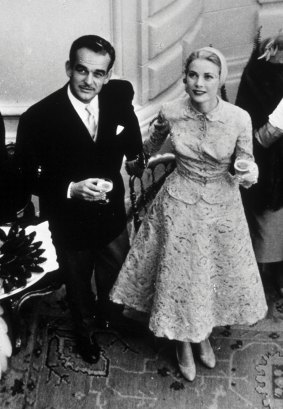
Rainier III, Prince of Monaco, with his wife Grace Kelly.
Perhaps the best spot of all for auto-voyeurism, if not shameless class envy, is Monte Carlo Casino Square. Fantasising is permissible if not de rigueur over the dream machines that gamblers park, snout-out, in front of the casino and adjacent Hotel de Paris. Pawing these svelte Lamborghinis and Maseratis is not, especially as bouncers built like tuxedoed outhouses hover nearby. I soothe my heavy metal envy by recalling one British journalist's irreverent take on the hallowed square: "The blokes driving the cars look more like money launderers than movie stars. And their lady companions look like (let's be charitable) their nieces."
There's little escaping things of speed and the wheel in Monaco, even over dinner. I eat one night at Stars'N'Bars, a popular harbourside sports bar diner that overlooks the grand prix "paddock" used by F1 race teams. The menu is Tex-Mex-international going organic. Two-time word champion Mika Hakkinen's McLaren-Mercedes hangs vertically on the wall like a crucified beast. Aussie motorcycle champ Mick Doohan's racing gloves and one boot (what happened to the other one?) are displayed in a cabinet, as is the late Ayrton Senna's race helmet. The delicious temaki salmon salad is appropriately up to speed.
Wandering the Monaco harbour foreshore, you inevitably pass a pair of monuments from motoring's glory days when a man would call, "Gentlemen, start your engines please." At the north end of the harbour – Port Hercules is its proper name – you find a life-sized bronze statue of British bolter William Grover-Williams rakishly angled at the wheel of his Bugatti 35B – no seatbelts, rollbars, or prima donna performers in those brave days. Legend has it that in 1929 Grover-Williams, an anonymous dark horse, arrived too late for race practice but soon stunned the crowd by trouncing a classy field, including Baron Philippe de Rothschild, to win Monaco's first grand prix. He averaged 80km/h. Today's drivers do it at almost twice that speed.
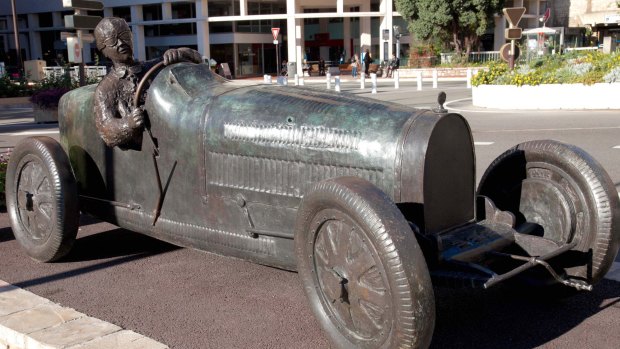
The bronze statue of British bolter William Grover-Williams at the wheel of his Bugatti 35B.Credit: John Borthwick
The second statue, of legendary Argentine driver Juan Manuel Fangio – "the Maestro" – and his 1955 Mercedes W196, stands near the famous La Rascasse corner. Five-times F1 world champion, and still holding the historic trifecta of the highest percentage of race wins, pole positions and front-row starts, Fangio enjoys a permanent place in the Monaco sun. And no more so than when a brace of 350km/h bolters roar past him 78 times on a Sunday afternoon every May.
TRIP NOTES
MORE
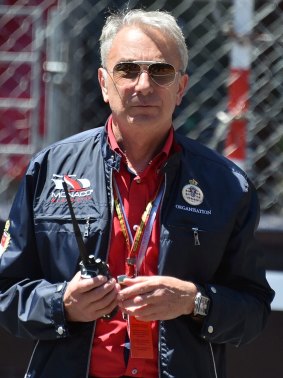
The race director of the Monaco Formula One Grand Prix, Michel Ferry.
traveller.com.au/Monaco; visitmonaco.com
VISIT
Monaco is a year-round destination. Australian passport holders do not need a visa.
ARRIVE
The closest airport is Nice, France, 20 kilometres west from where the spectacular, seven-minute helicopter flight to Monaco costs €145. The bus from Nice takes 40 minutes. Monaco is part of the French national rail network.
STAY
Four-star Hotel Columbus Monte-Carlo, from about $212 a night; check for seasonal deals. Grand prix period prices are much higher. columbusmonaco.com
John Borthwick travelled as a guest of Visit Monaco.
FIVE MORE THINGS TO DO
1. Casino Monte Carlo. Entry to the casino's ornate lobby is free; there's a €10 fee to visit the gaming area (bring your passport for ID purposes) and another €10 for other areas. Ian Fleming's first James Bond novel, Casino Royale (1953) drew its inspiration from this casino. casinomontecarlo.com
2. The Rock. This fabled outcrop has been home to the ruling Grimaldi clan for 700 years. Head there to see its palace apartments, museum, cathedral and gardens, and the changing of the guard. Note the literally "cloak-and-dagger" bronze of founder, Francesco Grimaldi – aka Il Malizia, "the Malicious One" – who captured the fortress in 1297 disguised as a monk. visitmonaco.com
3. Oceanographic Museum. Built into the cliff-face of the Rock, the 1910 oceanarium looks like a temple and is, indeed, one to marine science. Huge aquariums pulse with hundreds of beautiful species of sea life. Kids love its turtle island and tactile pool while adults go for Oceanomania's vast display of marine curiosities. visitmonaco.com
4. Eat well. There's no need to break the bank at Monte Carlo to eat. For lunch, try elegant Mozza cafe-restaurant with modern Mediterranean fare; mozza.mc. For dinner, Marcello, an Italian bodega featuring good wine and hams; marcellofoodvalley.com. For alfresco seafood, Les Perles de Monte Carlo is superbly located on the Fontvieille breakwater; perlesdemontecarlo.com. And for superior burgers hit Grubers – the name is an anagram; ilovegrubers.com.
5. Passport to Monte Carlo. Monaco Tourism offers bonuses to visitors who book two nights or more in low season or three in high season at participating hotels, including free helicopter transfer (conditions apply) and entrance to main museums and attractions. visitmonaco.com
MONACO'S FABULOUS MOTORING CALENDAR
January. Monte Carlo Rally. The world's oldest motor rally began in 1911 to lure winter visitors to Monaco. Twenty-three cars started from six European cities and 16 made it to the finish line. Now a prestigious annual event, the four-day rally through demanding alpine roads attracts about 70 professional competitors. Next rally: January 22-28, 2018.
January-February. Monte Carlo Historic Rally. Cars that participated in the Monte Carlo Rally between 1955 and 1980 are eligible to compete in the Rallye Monte-Carlo Historique, which began in 1998 and now attracts more than 300 entrants. Competitors start from seven European cities and finish at Monaco harbour. Next rally: January 31-February 7, 2018.
April. Top Marques Monaco. Touted as the world's most exclusive supercar show, the pitch – "See it! Drive it! Buy it!" – is uncharacteristically crass for this discrete principality. There are test drives (for VIPs) of its pricey toys on a section of the famed F1 track, plus "world premieres" of new supercars from Tesla, Alfa, Lotus, Kahn and Donkervoort. Next event: April 19-22, 2018.
May. Monte Carlo Historic Grand Prix. This retrospective, inaugurated in 1997, celebrates the golden age of motor sport and is held on even numbered years two weeks before the main F1 race. The Grand Prix de Monaco Historique is a true heart-starter for motor-racing tragics, with more than 180 classic, pre-war and post-war cars competing. Next race: May 11-13, 2018.
May. Monaco E-Prix. The first electric car grand prix (Formula E) was established in 2015 and runs on odd numbered years, two weeks before the F1 derby. Teams race electric-powered, single-seaters capable of speeds up to 225km/h. Plenty of squealing tyres but the roar of lusty exhausts is sorely missed. Next race: May 2019.
May. Monaco Formula One Grand Prix. Seventy-six years on, this remains the world's most glamorous car race. Passing is almost impossible on the narrow streets (Nelson Piquet likened racing here to "riding a bicycle around your living room") but the drivers let it rip through the famous tunnel. Next race: May 26-28, 2018.
October. Monte Carlo New and Renewable Energies Rally. The event has two categories, Rallye des Energies Nouvelles for electric, hybrid or alternative energy vehicles, and ZENN (Zero Emission No Noise) for fully electric cars. About 200 participants from 26 manufacturers compete, departing from four cities in France and Switzerland to finish in Monaco. Next rally: October 25-29, 2017.
Sign up for the Traveller Deals newsletter
Get exclusive travel deals delivered straight to your inbox. Sign up now.